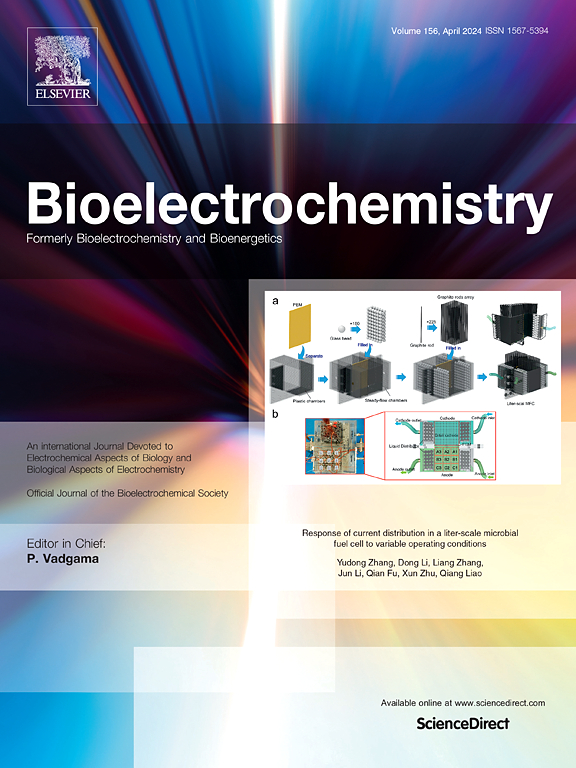Electrochemical response mechanism of DNA damaged cells: DNA damage repair and purine metabolism activation
IF 4.8
2区 化学
Q1 BIOCHEMISTRY & MOLECULAR BIOLOGY
引用次数: 0
Abstract
In modern society, due to the sharp increase in pollutants that cause DNA damage, there is a growing demand for innovative detection techniques and biomarkers. In this paper, the electrochemical behavior of HepG2 cells exposed to CdCl2 was investigated, and the electrochemical response mechanism of DNA damage was identified by exploring the correlation between the DNA damage response and purine metabolism. Western blot analysis revealed that the expression levels of ATM and Ku70 increased at 0.3 μM CdCl2, indicating a DNA damage response and activation of DNA repair processes. Simultaneously, elevated expression levels of PRPP aminotransferase, HPRT, and XOD were observed, leading to an increase in intracellular purine levels and electrochemical signals. The expression of Ku70 peaked at 0.5 μM CdCl2, indicating the highest DNA repair activity. The expression profiles of these purine metabolism proteins mirrored those of Ku70, suggesting a strong correlation between the activation of purine metabolism and DNA damage repair. Consistently, intracellular purine levels exhibited a similar trend, leading to corresponding changes in electrochemical signals. In summary, electrochemical using intracellular purines as biomarkers has the potential to emerge as a novel method for detecting early DNA damage.
DNA 损伤细胞的电化学反应机制:DNA 损伤修复和嘌呤代谢激活
在现代社会,由于导致DNA损伤的污染物急剧增加,人们对创新检测技术和生物标志物的需求与日俱增。本文研究了暴露于 CdCl2 的 HepG2 细胞的电化学行为,并通过探索 DNA 损伤反应与嘌呤代谢之间的相关性,确定了 DNA 损伤的电化学反应机制。Western 印迹分析显示,在 0.3 μM CdCl2 条件下,ATM 和 Ku70 的表达水平升高,表明存在 DNA 损伤应答并激活了 DNA 修复过程。同时,观察到 PRPP 转氨酶、HPRT 和 XOD 的表达水平升高,导致细胞内嘌呤水平和电化学信号增加。Ku70 的表达在 0.5 μM CdCl2 时达到峰值,表明其 DNA 修复活性最高。这些嘌呤代谢蛋白的表达谱与 Ku70 的表达谱相似,表明嘌呤代谢的激活与 DNA 损伤修复之间存在密切联系。同样,细胞内的嘌呤水平也呈现出类似的趋势,从而导致电化学信号发生相应的变化。总之,利用细胞内嘌呤作为生物标记物的电化学方法有可能成为检测早期 DNA 损伤的一种新方法。
本文章由计算机程序翻译,如有差异,请以英文原文为准。
求助全文
约1分钟内获得全文
求助全文
来源期刊

Bioelectrochemistry
生物-电化学
CiteScore
9.10
自引率
6.00%
发文量
238
审稿时长
38 days
期刊介绍:
An International Journal Devoted to Electrochemical Aspects of Biology and Biological Aspects of Electrochemistry
Bioelectrochemistry is an international journal devoted to electrochemical principles in biology and biological aspects of electrochemistry. It publishes experimental and theoretical papers dealing with the electrochemical aspects of:
• Electrified interfaces (electric double layers, adsorption, electron transfer, protein electrochemistry, basic principles of biosensors, biosensor interfaces and bio-nanosensor design and construction.
• Electric and magnetic field effects (field-dependent processes, field interactions with molecules, intramolecular field effects, sensory systems for electric and magnetic fields, molecular and cellular mechanisms)
• Bioenergetics and signal transduction (energy conversion, photosynthetic and visual membranes)
• Biomembranes and model membranes (thermodynamics and mechanics, membrane transport, electroporation, fusion and insertion)
• Electrochemical applications in medicine and biotechnology (drug delivery and gene transfer to cells and tissues, iontophoresis, skin electroporation, injury and repair).
• Organization and use of arrays in-vitro and in-vivo, including as part of feedback control.
• Electrochemical interrogation of biofilms as generated by microorganisms and tissue reaction associated with medical implants.
 求助内容:
求助内容: 应助结果提醒方式:
应助结果提醒方式:


